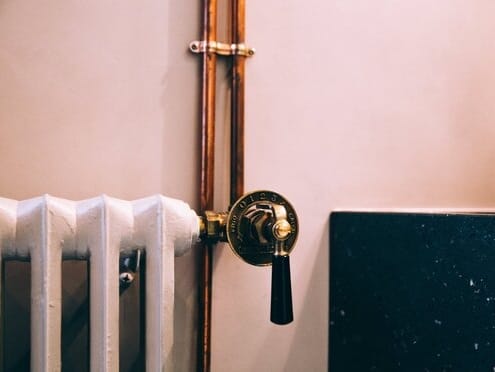
Warmte is met een aandeel van meer dan 50% de belangrijkste component in het energieverbruik in Vlaanderen. Bij gezinnen loopt dat zelfs tot driekwart van hun energiegebruik op. 85% van de Vlamingen verwarmt de woning met fossiele brandstoffen. Tegen 2050 zouden jaarlijks bijna 100.000 gezinnen hun warmtevoorziening moeten verduurzamen. Dat is een van de grote uitdagingen waarop het Warmteplan inzet.
Nieuwbouw eerst
Nieuwbouw (zowel residentieel als niet-residentieel) wordt de voorloper in de omslag van fossiel naar klimaatvriendelijk. Na de uitfasering van stookolie vanaf 2022, laten omgevingsvergunningen vanaf 1 januari 2026 geen aardgasaansluiting meer toe. De warmtepomp of het aansluiten op een warmtenet wordt de norm. Bij nieuwbouw die de komende jaren wordt gebouwd, wordt het belangrijk om al vloerverwarming of radiatoren op lage temperatuur te voorzien, zodat er later geen breekwerk nodig is om de woning volledig duurzaam te verwarmen. In tussentijd zal het aandeel groene warmte al stijgen: bij vergunningsaanvragen vanaf 1 januari 2023 zal een condensatieketel niet langer volstaan voor wie nog met aardgas wil verwarmen. Een hybride warmtepomp wordt de minimale vereiste. Een hybride warmtepomp is een warmtepomp die warmte uit de omgeving haalt en op de koudste dagen nog kan bijverwarmen met aardgas.
Bestaande gebouwen volgen
De verplichtingen voor nieuwbouw geven de richting aan voor bestaande gebouwen. Bestaande gebouwen moeten tegen 2050 de energie-efficiëntie van nieuwbouw evenaren. In de volgende jaren wordt die evolutie stapsgewijs op gang gebracht. Dat gebeurt vooral via sensibiliseren, premies en renteloze leningen. Omdat halsoverkop investeren tot halfslachtige of duurdere renovaties kan leiden, wordt een planmatige aanpak aangeraden: eerst het energiegebruik verlagen door het hele gebouw grondig te isoleren, daarna overschakelen op vloerverwarming of een ander systeem op lage temperatuur en aansluitend het gebruik van fossiele brandstoffen afbouwen. Onder meer de premies voor warmtepompen en de renteloze leningen worden verhoogd en uitgebreid.
Warmtenetten en meer
Ook warmtenetten worden steeds belangrijker. Vandaag zijn er al een 75-tal warmtenetten in Vlaanderen. Langs ondergrondse buizen transporteren ze warmte van bijvoorbeeld een warmtecentrale of een bedrijf dat warmte op overschot heeft naar andere bedrijven, scholen, ziekenhuizen of woningen. Als er in de buurt een warmtenet komt, kan het interessanter zijn om daarop aan te sluiten dan te investeren in een eigen verwarmingsinstallatie. Het Warmteplan voorziet dat de aansluitpremie voor bestaande woningen op warmtenetten wordt onderzocht en voorziet ook meer middelen voor de ondersteuning van projecten die gebruik maken van groene warmte, restwarmte en duurzame warmtenetten.
Het Warmteplan 2025 bevat 26 maatregelen om de omslag te maken naar duurzaam verwarmen en het vergroenen van energiedragers. Het plan zorgt daarmee voor de uitvoering van de doelstellingen rond groene warmte en restwarmte in het Regeerakkoord 2019-2024, de beleidsnota Energie 2019-2024 en het Vlaams Energie- en Klimaatplan 2021-2030. De Vlaamse minister bevoegd voor Energie zal zorgen voor de verdere uitwerking van deze acties. Alle minister zullen zelf de maatregelen uitvoeren die onder hun bevoegdheid vallen.
Groene warmte is, net zoals zon en wind, vaak een lokaal verhaal met verschillende spelers. Provincies, steden en gemeenten hebben een grote rol, maar ook bedrijven, kennisinstellingen en andere organisaties zijn belangrijk om dit plan te doen slagen.
Bron: VEKA






